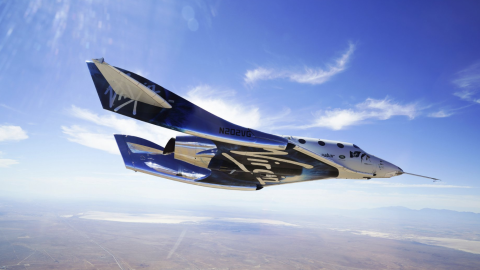Virgin Galactic passenger rocket reaches space in test flight

Virgin Galactic
- The rocket, dubbed SpaceShipTwo, reached an altitude of 51 miles on Thursday.
- Virgin Galactic hopes to soon transport space tourists into the atmosphere on the rocket.
- The successful test is a landmark for Virgin Galactic, which has seen its fair share of setbacks since it was founded in 2004.
In a successful test of what Virgin Galactic founder Richard Branson hopes will be “the world’s first commercial spaceline,” the company launched a spacecraft 51 miles above California’s Mojave Desert on Thursday.
That altitude qualifies as space, according to the Federal Aviation Administration’s definition.
The spacecraft, known as SpaceShipTwo, was ferried by a mothership to an altitude of 43,000 feet. Then it was released, falling freely until one of the two pilots ignited the engine, rocketing the ship nearly straight upward into the mesosphere at Mach 2.9 (2,225 mph). The ship then began its gliding descent back to ground, landing on a runway and ending the approximately 20-minute test.
“Space is Virgin territory!” Virgin Galactic founder Richard Branson told the pilots after they landed.
A milestone for Virgin Galactic
Reaching today’s milestone has been a long haul for Virgin Galactic. After founding the company in 2004, Branson had estimated that Virgin would have a fleet of spacecraft transporting passengers by 2007. But that same year, three technicians were killed by an explosion while testing a propellant system.
In 2014, a Virgin Galactic co-pilot was killed after an experimental craft tore apart in midair during a test flight. Technical problems had long plagued that craft’s development before the explosion, according to a Wall Street Journal report.
Branson had considered halting the space program altogether, but ultimately decided to press on. Now, the company’s goal is to build a series of spaceports around the globe that would enable “tens of thousands of people to experience space,” George Whitesides, Virgin Galactic’s chief executive, said in a recent interview.
The private space race
In addition to Virgin Galactic, Jeff Bezos’ Blue Origin also hopes to launch space tourists into the atmosphere, albeit by launching a capsule into sub-orbit via rocket instead of by spaceplane. Meanwhile, SpaceX is planning to take astronauts to the International Space Station, and recently announced plans to take a Japanese billionaire and his guests on a special voyage around the moon.
Over the long term, Virgin Galactic hopes to turn its spaceports into hubs “for a network of intercontinental transportation nodes” where spaceships would transport passengers across the globe in a matter of hours.





